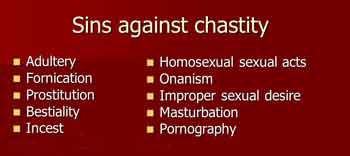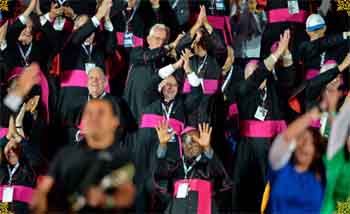Asuntos Tradicionalistas
 |
 |
 |
 |
 |
 |
 |
Misa Dialogada - CXXIX
La falacia de la "culpabilidad por asociación"
Una de las tácticas favoritas del Papa Francisco es mancillar la reputación de los tradicionalistas –en particular de los clérigos– acusándolos de “rigidez” y colocándolos en la categoría de aquellos condenados por Nuestro Señor en los Evangelios, es decir, fariseos e hipócritas. Desafortunadamente, no distingue entre la rigidez de aquellos que tienen una lealtad fuerte e inquebrantable a la doctrina y disciplina de la Iglesia (éstas son específicamente condenadas), y la rigidez de los fariseos que anteponen la observancia de las leyes creadas por los hombres a la caridad confiando en su propia justicia propia y despreciando a los demás.
En lugar de ello, emite una condena general a todos aquellos que “observan ciertas reglas o permanecen intransigentemente fieles a un estilo católico particular del pasado”, y los acusa de “neopelagianismo prometeico ensimismado” porque “en última instancia, sólo confían en sus propios poderes y se sienten superiores al resto.”1
Pero esto es simplemente un ataque ad hominem basado en especulaciones poco caritativas; ve a los católicos tradicionales de la peor manera posible y no hace nada para explicar por qué es correcto y apropiado valorar la Tradición católica y permanecer “intransigentemente fiel” a ella.
Francisco aumenta las críticas injustas, dirigiendo sus ataques contra aquellos que se han mantenido fieles a la doctrina católica ortodoxa:
“Una supuesta solidez de doctrina o disciplina conduce, en cambio, a un elitismo narcisista y autoritario”.
Esto es, por supuesto, sólo otra variación del viejo cliché “clericalista” de “enseñorearse” de los fieles. No siente más que desprecio por la catequesis tradicional, que caricaturiza de esta manera:
“En lugar de evangelizar, uno analiza y clasifica a los demás, y en lugar de abrir la puerta a la gracia, agota sus energías en inspeccionar y verificar.”
 El sutil trasfondo de desprecio en esta acusación puede no ser evidente para todos, pero ciertamente resonará entre los neomodernistas, es decir, los eruditos bíblicos, filósofos y teólogos católicos, tanto clericales como laicos, que exigen libertad de todas las regulaciones impuestas por las autoridades eclesiásticas.
El sutil trasfondo de desprecio en esta acusación puede no ser evidente para todos, pero ciertamente resonará entre los neomodernistas, es decir, los eruditos bíblicos, filósofos y teólogos católicos, tanto clericales como laicos, que exigen libertad de todas las regulaciones impuestas por las autoridades eclesiásticas.
Al ponerse abiertamente de su lado, Francisco ha demostrado simpatizar con todos los revolucionarios que prevalecieron en el Vaticano II, razón por la cual se niega a actuar como la voz autorizada de Cristo en cuestiones de fe y moral.
En cuanto a su queja de que las personas están sujetas a “inspección y verificación”, estas actividades encontraron una enérgica oposición de los liberales de todas las tendencias, pero fueron el medio indispensable utilizado por la Iglesia a lo largo de los siglos para investigar ( que es lo que significa la palabra Inquisición) a quienes intentan subvertir la Fe a través de su predicación y sus libros.
El Papa Pío V, por ejemplo, fue un Inquisidor que trabajó por la salvación de las almas contrarrestando la difusión de ideas heréticas durante la Reforma Protestante. El Papa Pío X, en su motu proprio de 1910, instó a los obispos del mundo a erradicar cualquier signo de modernismo en sus diócesis, advirtiéndoles que nunca relajaran su vigilancia y severidad (es decir, su “rigidez”). 2
En el nuevo régimen progresista, por el contrario, a todos se les permite promover sus propias innovaciones y opiniones doctrinales, y existe una tolerancia generalizada hacia los graves males morales relacionados con el Sexto Mandamiento, bajo el disfraz de “misericordia” e “inclusión”. En este ámbito, el propio Francisco ha alentado a algunos a considerarse justificados para recibir la Sagrada Comunión sin arrepentimiento ni propósito de enmienda.
La rigidez del Sexto Mandamiento
Esto nos lleva al tratamiento arrogante de Francisco de los pecados de la carne, que desestimó, en una charla con sus compañeros jesuitas, como uno de los pecados “menos graves”. Aquí su línea de razonamiento es errónea.
 Sólo por el hecho de que Santo Tomás de Aquino clasifique los pecados de la carne, incluida la lujuria, como menos graves que los del intelecto, como el orgullo, no se sigue que sean los menos graves de todos. Sin embargo, Francisco utilizó este non sequitur para trivializar los pecados contra el Sexto Mandamiento, yendo así en contra de toda la tradición bíblica y de los Padres y Doctores de la Iglesia.3 Continuó acusando al clero moralizante de exagerar obsesivamente tales pecados:
Sólo por el hecho de que Santo Tomás de Aquino clasifique los pecados de la carne, incluida la lujuria, como menos graves que los del intelecto, como el orgullo, no se sigue que sean los menos graves de todos. Sin embargo, Francisco utilizó este non sequitur para trivializar los pecados contra el Sexto Mandamiento, yendo así en contra de toda la tradición bíblica y de los Padres y Doctores de la Iglesia.3 Continuó acusando al clero moralizante de exagerar obsesivamente tales pecados:
“Una dimensión del clericalismo es la fijación moral exclusiva en el sexto mandamiento... Nos centramos en el sexo y luego no damos importancia a la injusticia social, la calumnia, los chismes y las mentiras. La Iglesia hoy necesita una profunda conversión en este ámbito”.4
Pero esto es totalmente falso y puede ser fácilmente refutado por la evidencia que nos rodea. La mayoría de los obispos adoptan una postura de silencio o ambigüedad (lo que sugiere incredulidad) sobre el Sexto Mandamiento. Prácticamente ningún sacerdote del Novus Ordo se atrevería a mencionar los pecados de impureza en sus sermones o a criticar la moda inmodesta que usan las mujeres incluso en la iglesia.
 Desde el Vaticano II, la Iglesia ha estado inundada de cuestiones de “justicia social” y “ambientales”, mientras que calumnias, chismes y mentiras circulan libremente contra los tradicionalistas, incluido, como hemos visto, el propio Francisco.
Desde el Vaticano II, la Iglesia ha estado inundada de cuestiones de “justicia social” y “ambientales”, mientras que calumnias, chismes y mentiras circulan libremente contra los tradicionalistas, incluido, como hemos visto, el propio Francisco.
Dado su largo historial de acusar a sacerdotes tradicionalistas de “clericalismo”, podemos concluir que sus comentarios iban dirigidos contra ellos. Pero incluso aquí estaría equivocado, ya que se sabe que los sacerdotes que se formaron en los seminarios tradicionales de hoy, y se guían por los manuales y libros de texto de teología moral anteriores al Vaticano II muestran un enfoque imparcial ante todas las cuestiones morales. Acusarlos de tener una “fijación moral exclusiva en el Sexto Mandamiento” es a la vez falso y calumnioso.
 Para entender de dónde viene Francisco en esta acusación particular, debemos tener en cuenta su predilección por repetir consignas progresistas y por adoptar opiniones modernistas y de izquierda que son perjudiciales para la Iglesia. Su comentario antes mencionado encaja exactamente en el paradigma de crítica dirigida rutinariamente a la Iglesia desde el surgimiento de la Teología de la Liberación a mediados del siglo XX.
Para entender de dónde viene Francisco en esta acusación particular, debemos tener en cuenta su predilección por repetir consignas progresistas y por adoptar opiniones modernistas y de izquierda que son perjudiciales para la Iglesia. Su comentario antes mencionado encaja exactamente en el paradigma de crítica dirigida rutinariamente a la Iglesia desde el surgimiento de la Teología de la Liberación a mediados del siglo XX.
En ese entonces (y hoy todavía) los revolucionarios radicales empeñados en cambiar las doctrinas y estructuras de la Iglesia afirmaron que demasiados sacerdotes y religiosos ponían énfasis casi exclusivamente en los pecados contra el Sexto Mandamiento, mientras permanecían ciegos a las exigencias más elementales de la “justicia social” y “solidaridad social”. Este fue el mensaje básico de la mayoría de los teólogos de la liberación desde la década de 1960 5 hasta el día de hoy, y Francisco lo abraza de todo corazón.
Además, Francisco da la impresión de subestimar la doble malicia del adulterio. Parece olvidar que no es sólo un pecado de lujuria contrario a la Ley Natural, sino también contra la “justicia social” en la medida en que destruye la familia, daña el bienestar de niños inocentes y va contra el bien de la sociedad pretendido por Dios. También debemos tener en cuenta los efectos de los pecados de impureza en la moral pública, ahora sumergida en un pantano de placer venéreo, y en la educación, donde la obsesión por el sexo ha corrompido las mentes de los niños incluso en la escuela infantil.
Un Papa verdaderamente “pastoral” defendería la ley moral con rigidez, como se instruye en los Evangelios (Mateo 5:18), donde Nuestro Señor, que no vino a abolir sino a cumplir la Ley, dijo que “ni un ápice” debe ser alejado de los principios morales y espirituales. Pero esto es inaceptable para los progresistas porque no aceptan la inmutabilidad de la fe y la moral católicas. Creen que la Iglesia debería adaptar su enseñanza a las demandas de cada generación que pasa, dejar de condenar los errores teológicos, permitir la libertad de las restricciones en cuestiones morales y estar más abierta a la influencia de los valores mundanos, todo en aras de volverse más “humanos”.
 Desastrosamente para la Iglesia y la sociedad, Francisco ha dado la impresión en
Amoris laetitia de que las violaciones graves de la Ley Moral pueden contar con la aprobación de la Iglesia en casos de presunta sinceridad subjetiva y conciencia individual.
Desastrosamente para la Iglesia y la sociedad, Francisco ha dado la impresión en
Amoris laetitia de que las violaciones graves de la Ley Moral pueden contar con la aprobación de la Iglesia en casos de presunta sinceridad subjetiva y conciencia individual.
En lugar de condenar rotundamente la inmoralidad desenfrenada que se manifiesta evidentemente a nuestro alrededor –que resultó en el colapso de las tasas de matrimonio y natalidad, el aborto legalizado y la eutanasia, la “apostasía silenciosa” del cristianismo y el colapso de la civilización occidental– prefiere atacar a quienes defienden la moral rígida que la Iglesia Católica ha venido predicando desde su fundación hasta el Vaticano II. Al hacerlo, ha derribado la barrera más eficaz contra la actual marea de inmoralidad en nuestra sociedad.
Cuando consideramos las consecuencias de abandonar la rigidez de la moral católica, queda claro que, contrariamente a la afirmación de Francisco, no es la Iglesia de Tradición Católica la que “necesita una conversión profunda en este ámbito”, sino el propio Francisco y el tipo de Iglesia que ha creado el Vaticano II.
La rigidez del “blanco y negro”
Los modernistas desprecian las exposiciones claras de la doctrina católica –Francisco las ve como un obstáculo para la “Nueva Evangelización”– basándose en el viejo adagio de que no todas las situaciones son blancas o negras; algunas áreas son grises y no hay nada bueno o malo en un sentido absoluto. En 2016, Francisco adoptó este enfoque como contrapeso a la “rigidez” cuando habló con un grupo de sacerdotes jesuitas sobre el tema de dar consejos en el confesionario.
"Mucha gente sale del confesionario desilusionada", se quejó, porque los sacerdotes "rígidos" imponen la ley y les dicen "debes hacer esto, no debes hacer aquello".6 Reiteró esta noción poco después cuando dijo a la comunidad del Seminario Pontificio Mayor de Roma que “la rigidez significa básicamente tomar un látigo en la mano con el Pueblo de Dios: no se puede hacer esto, no se puede hacer aquello”. Y así, “muchas personas se acercan buscando un poco de consuelo, un poco de comprensión”, pero en cambio quedan “distanciadas por esta rigidez”. 7
 Pero esto pasa por alto el punto fundamental de los Evangelios, en los que Nuestro Señor nos dio una opción en términos muy rígidos, en blanco y negro, con consecuencias eternas: Cielo o Infierno; la “puerta estrecha” o el “camino ancho”; el camino de la Vida o de la Muerte; las ovejas o las cabras; “El que no está conmigo, está contra mí; y el que conmigo no recoge, desparrama. (Mat. 12:30) E, incidentalmente, tomó un látigo en la mano para expulsar a los cambistas del Templo.
Pero esto pasa por alto el punto fundamental de los Evangelios, en los que Nuestro Señor nos dio una opción en términos muy rígidos, en blanco y negro, con consecuencias eternas: Cielo o Infierno; la “puerta estrecha” o el “camino ancho”; el camino de la Vida o de la Muerte; las ovejas o las cabras; “El que no está conmigo, está contra mí; y el que conmigo no recoge, desparrama. (Mat. 12:30) E, incidentalmente, tomó un látigo en la mano para expulsar a los cambistas del Templo.
Los católicos siempre han entendido esta marcada dicotomía como una parte inmutable de la fe. El catecismo más antiguo (la Didajé), elaborado en los primeros años del cristianismo, da como primer punto doctrinal:
“Hay dos caminos, uno de vida y otro de muerte, y hay una gran diferencia entre estos dos caminos”.
Esta enseñanza prevaleció en la Iglesia hasta que los defensores de la “Nueva Moral” relativizaron los Mandamientos, permitiendo a los fieles imaginar que podían escapar del juicio de Dios y adaptar la Ley Moral según la forma en que cada uno subjetivamente ve mejor.
El problema con el enfoque de Francisco es que su juicio sobre cuestiones morales se basó en una perspectiva humana más que divina, y en un ángulo protestante más que católico. Significativamente, Pío XII ya había explicado cómo la “Nueva Moral” surgió “desde fuera de la fe y de los principios católicos”, derivando inicialmente del existencialismo que trataba a Dios como una abstracción o negaba su existencia por completo.8
A esto podemos agregar las contribuciones de varios teólogos protestantes contemporáneos que fueron inmensamente influyentes en los círculos progresistas de mediados del siglo XX y que fueron fácilmente adoptados dentro de la Iglesia con la bendición del Vaticano II.9
Continuará

En lugar de ello, emite una condena general a todos aquellos que “observan ciertas reglas o permanecen intransigentemente fieles a un estilo católico particular del pasado”, y los acusa de “neopelagianismo prometeico ensimismado” porque “en última instancia, sólo confían en sus propios poderes y se sienten superiores al resto.”1
Pero esto es simplemente un ataque ad hominem basado en especulaciones poco caritativas; ve a los católicos tradicionales de la peor manera posible y no hace nada para explicar por qué es correcto y apropiado valorar la Tradición católica y permanecer “intransigentemente fiel” a ella.
Francisco aumenta las críticas injustas, dirigiendo sus ataques contra aquellos que se han mantenido fieles a la doctrina católica ortodoxa:
“Una supuesta solidez de doctrina o disciplina conduce, en cambio, a un elitismo narcisista y autoritario”.
Esto es, por supuesto, sólo otra variación del viejo cliché “clericalista” de “enseñorearse” de los fieles. No siente más que desprecio por la catequesis tradicional, que caricaturiza de esta manera:
“En lugar de evangelizar, uno analiza y clasifica a los demás, y en lugar de abrir la puerta a la gracia, agota sus energías en inspeccionar y verificar.”

Francisco detesta el catecismo tradicional enseñado en las clases de antaño así como el ambiente disciplinado
Al ponerse abiertamente de su lado, Francisco ha demostrado simpatizar con todos los revolucionarios que prevalecieron en el Vaticano II, razón por la cual se niega a actuar como la voz autorizada de Cristo en cuestiones de fe y moral.
En cuanto a su queja de que las personas están sujetas a “inspección y verificación”, estas actividades encontraron una enérgica oposición de los liberales de todas las tendencias, pero fueron el medio indispensable utilizado por la Iglesia a lo largo de los siglos para investigar ( que es lo que significa la palabra Inquisición) a quienes intentan subvertir la Fe a través de su predicación y sus libros.
El Papa Pío V, por ejemplo, fue un Inquisidor que trabajó por la salvación de las almas contrarrestando la difusión de ideas heréticas durante la Reforma Protestante. El Papa Pío X, en su motu proprio de 1910, instó a los obispos del mundo a erradicar cualquier signo de modernismo en sus diócesis, advirtiéndoles que nunca relajaran su vigilancia y severidad (es decir, su “rigidez”). 2
En el nuevo régimen progresista, por el contrario, a todos se les permite promover sus propias innovaciones y opiniones doctrinales, y existe una tolerancia generalizada hacia los graves males morales relacionados con el Sexto Mandamiento, bajo el disfraz de “misericordia” e “inclusión”. En este ámbito, el propio Francisco ha alentado a algunos a considerarse justificados para recibir la Sagrada Comunión sin arrepentimiento ni propósito de enmienda.
La rigidez del Sexto Mandamiento
Esto nos lleva al tratamiento arrogante de Francisco de los pecados de la carne, que desestimó, en una charla con sus compañeros jesuitas, como uno de los pecados “menos graves”. Aquí su línea de razonamiento es errónea.

Pecados nunca mencionados por Francisco y los progresistas
“Una dimensión del clericalismo es la fijación moral exclusiva en el sexto mandamiento... Nos centramos en el sexo y luego no damos importancia a la injusticia social, la calumnia, los chismes y las mentiras. La Iglesia hoy necesita una profunda conversión en este ámbito”.4
Pero esto es totalmente falso y puede ser fácilmente refutado por la evidencia que nos rodea. La mayoría de los obispos adoptan una postura de silencio o ambigüedad (lo que sugiere incredulidad) sobre el Sexto Mandamiento. Prácticamente ningún sacerdote del Novus Ordo se atrevería a mencionar los pecados de impureza en sus sermones o a criticar la moda inmodesta que usan las mujeres incluso en la iglesia.

Los obispos rockean en la JMJ para complacer a los jóvenes, no para corregirlos
Dado su largo historial de acusar a sacerdotes tradicionalistas de “clericalismo”, podemos concluir que sus comentarios iban dirigidos contra ellos. Pero incluso aquí estaría equivocado, ya que se sabe que los sacerdotes que se formaron en los seminarios tradicionales de hoy, y se guían por los manuales y libros de texto de teología moral anteriores al Vaticano II muestran un enfoque imparcial ante todas las cuestiones morales. Acusarlos de tener una “fijación moral exclusiva en el Sexto Mandamiento” es a la vez falso y calumnioso.

Los centros católicos alientan a los jóvenes a participar en causas de “justicia social”
En ese entonces (y hoy todavía) los revolucionarios radicales empeñados en cambiar las doctrinas y estructuras de la Iglesia afirmaron que demasiados sacerdotes y religiosos ponían énfasis casi exclusivamente en los pecados contra el Sexto Mandamiento, mientras permanecían ciegos a las exigencias más elementales de la “justicia social” y “solidaridad social”. Este fue el mensaje básico de la mayoría de los teólogos de la liberación desde la década de 1960 5 hasta el día de hoy, y Francisco lo abraza de todo corazón.
Además, Francisco da la impresión de subestimar la doble malicia del adulterio. Parece olvidar que no es sólo un pecado de lujuria contrario a la Ley Natural, sino también contra la “justicia social” en la medida en que destruye la familia, daña el bienestar de niños inocentes y va contra el bien de la sociedad pretendido por Dios. También debemos tener en cuenta los efectos de los pecados de impureza en la moral pública, ahora sumergida en un pantano de placer venéreo, y en la educación, donde la obsesión por el sexo ha corrompido las mentes de los niños incluso en la escuela infantil.
Un Papa verdaderamente “pastoral” defendería la ley moral con rigidez, como se instruye en los Evangelios (Mateo 5:18), donde Nuestro Señor, que no vino a abolir sino a cumplir la Ley, dijo que “ni un ápice” debe ser alejado de los principios morales y espirituales. Pero esto es inaceptable para los progresistas porque no aceptan la inmutabilidad de la fe y la moral católicas. Creen que la Iglesia debería adaptar su enseñanza a las demandas de cada generación que pasa, dejar de condenar los errores teológicos, permitir la libertad de las restricciones en cuestiones morales y estar más abierta a la influencia de los valores mundanos, todo en aras de volverse más “humanos”.

Francisco facilita que los católicos
obtengan anulaciones y divorcios
En lugar de condenar rotundamente la inmoralidad desenfrenada que se manifiesta evidentemente a nuestro alrededor –que resultó en el colapso de las tasas de matrimonio y natalidad, el aborto legalizado y la eutanasia, la “apostasía silenciosa” del cristianismo y el colapso de la civilización occidental– prefiere atacar a quienes defienden la moral rígida que la Iglesia Católica ha venido predicando desde su fundación hasta el Vaticano II. Al hacerlo, ha derribado la barrera más eficaz contra la actual marea de inmoralidad en nuestra sociedad.
Cuando consideramos las consecuencias de abandonar la rigidez de la moral católica, queda claro que, contrariamente a la afirmación de Francisco, no es la Iglesia de Tradición Católica la que “necesita una conversión profunda en este ámbito”, sino el propio Francisco y el tipo de Iglesia que ha creado el Vaticano II.
La rigidez del “blanco y negro”
Los modernistas desprecian las exposiciones claras de la doctrina católica –Francisco las ve como un obstáculo para la “Nueva Evangelización”– basándose en el viejo adagio de que no todas las situaciones son blancas o negras; algunas áreas son grises y no hay nada bueno o malo en un sentido absoluto. En 2016, Francisco adoptó este enfoque como contrapeso a la “rigidez” cuando habló con un grupo de sacerdotes jesuitas sobre el tema de dar consejos en el confesionario.
"Mucha gente sale del confesionario desilusionada", se quejó, porque los sacerdotes "rígidos" imponen la ley y les dicen "debes hacer esto, no debes hacer aquello".6 Reiteró esta noción poco después cuando dijo a la comunidad del Seminario Pontificio Mayor de Roma que “la rigidez significa básicamente tomar un látigo en la mano con el Pueblo de Dios: no se puede hacer esto, no se puede hacer aquello”. Y así, “muchas personas se acercan buscando un poco de consuelo, un poco de comprensión”, pero en cambio quedan “distanciadas por esta rigidez”. 7

Francisco regaña las confesiones tradicionales y rígidas
Los católicos siempre han entendido esta marcada dicotomía como una parte inmutable de la fe. El catecismo más antiguo (la Didajé), elaborado en los primeros años del cristianismo, da como primer punto doctrinal:
“Hay dos caminos, uno de vida y otro de muerte, y hay una gran diferencia entre estos dos caminos”.
Esta enseñanza prevaleció en la Iglesia hasta que los defensores de la “Nueva Moral” relativizaron los Mandamientos, permitiendo a los fieles imaginar que podían escapar del juicio de Dios y adaptar la Ley Moral según la forma en que cada uno subjetivamente ve mejor.
El problema con el enfoque de Francisco es que su juicio sobre cuestiones morales se basó en una perspectiva humana más que divina, y en un ángulo protestante más que católico. Significativamente, Pío XII ya había explicado cómo la “Nueva Moral” surgió “desde fuera de la fe y de los principios católicos”, derivando inicialmente del existencialismo que trataba a Dios como una abstracción o negaba su existencia por completo.8
A esto podemos agregar las contribuciones de varios teólogos protestantes contemporáneos que fueron inmensamente influyentes en los círculos progresistas de mediados del siglo XX y que fueron fácilmente adoptados dentro de la Iglesia con la bendición del Vaticano II.9
Continuará
- Francis, Evangelii Gaudium, 2013, § 94
- Pius X, Antistitum sacrorum, (The Oath against Modernism), 1910: “Hisce ausibus contra evangelicam doctrinam et ecclesiasticam traditionem nunquam satis opponetur vigilantiae aut severitatis nimium ab iis quibus commissa est sacri huius depositi custodia fidelis.” (There can never be enough vigilance and firmness from those entrusted with the faithful safe-keeping of the sacred deposit of evangelical doctrine and ecclesiastical tradition, in combating these bold attacks against them).
- In contradiction to Pope Francis, the eminent Doctor of the Church, St Alphonsus Liguori, considered by Pope Pius XII to be the Patron of moral theologians, said that through these sins “most souls fall into Hell”, and that “all reprobates are condemned by them, or at least not without them.” (Theologia Moralis, lib. III, tract. IV, c. II)
- Antonio Spadaro, ‘The Sovereignty of the People of God: The Pontiff meets the Jesuits of Mozambique and Madagascar,’ La Civiltà Cattolica, September 26, 2019.
- Cf. Louis Monden SJ, Sin, Liberty and the Law. New York: Sheed and Ward, 1965, pp. 112-115.
- Francis, ‘Q&A session with Polish Jesuits at a private meeting during World Youth Day in Krakow,’ July 30, 2016, published in Rome on August 26, 2016 in the Jesuit Journal, La Civiltà Cattolica, by its Editor, Fr. Antonio Spadaro, SJ, who was present at the meeting.
- Francis, ‘Mediators or intermediaries,’ Address to the community of the Pontifical Roman Major Seminary, Morning Meditation in the Chapel of the Domus Sanctae Marthae, December 9, 2016.
- Pius XII, op. cit., April 18, 1952.
- For example, the works of the following Protestant theologians: Swiss Reformed Church Pastor Emil Brunner, The Divine Imperative (1941), Evangelical Pastor Reinhold Niebuhr, Moral Man and Immoral Society: a Study of Ethics and Politics (1932), Baptist Minister Harvey Cox, The Secular City (1965), Lutheran Pastor Dietrich Bonhoeffer, Ethics (1949), John A. T. Robinson, Anglican Bishop of Woolwich, Honest to God (1963) and Episcopalian priest-turned-atheist Joseph Fletcher, Situation Ethics: The New Morality (1966).
Publicado el 24 de agosto de 2023

______________________
______________________
 Volume I |
 Volume II |
 Volume III |
 Volume IV |
 Volume V |
 Volume VI |
 Volume VII |
 Volume VIII |
 Volume IX |
 Volume X |
 Volume XI |
 Special Edition |








